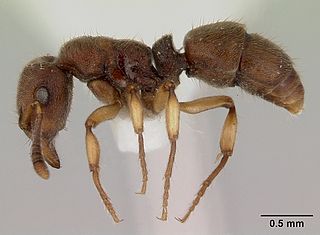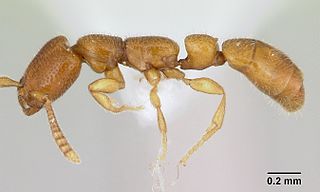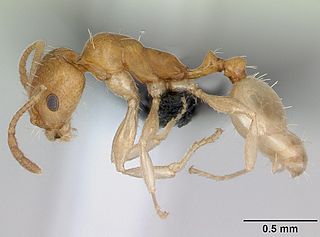Barry Bolton is an English myrmecologist, an expert on the classification, systematics, and taxonomy of ants, who long worked at the Natural History Museum (London). He is known especially for monographs on African and Asian ants and for three encyclopaedic global works, including the Identification Guide to Ant Genera (1994), a full catalogue of ant taxa, and a synopsis and classification (2003). Now retired, Bolton is a Fellow of the Royal Entomological Society and Myrmecologist, Biodiversity Division, Department of Entomology, Natural History Museum, London.

Proceratiinae is a subfamily of ants in the poneromorph subfamilies group, with three extant genera, of which most are tropical or subtropical, although overall distribution is worldwide.

Heteroponerinae is a subfamily of ants in the poneromorph subfamilies group containing three genera in one tribe. The subfamily was created in 2003 when Barry Bolton divided the Ponerinae subfamily into six subfamilies.

Ectatomminae is a subfamily of ants in the poneromorph subfamilies group containing four extant and three extinct genera in two tribes. The subfamily was created in 2003 when Barry Bolton divided the Ponerinae subfamily into six subfamilies.

Amblyoponinae is a subfamily of ants in the poneromorph subfamilies group containing 13 extant genera and one extinct genus. The ants in this subfamily are mostly specialized subterranean predators. Adult workers pierce the integument of their larvae to imbibe haemolymph, earning them the common name Dracula ant.

Vicinopone is a monotypic Afrotropical genus of arboreal ants in the subfamily Dorylinae. Vicinopone conciliatrix, the only species in the genus, was first described as Simopone conciliatrix by Brown in 1975 and was transferred to its own genus by Bolton & Fisher in 2012. V. conciliatrix appears to be quite widely distributed but rare. Its rarity is more likely apparent than real because it nests and forages in trees, rarely if ever coming down to the ground.
Tanipone is a Malagasy genus of ants in the subfamily Dorylinae.

Promyopias is an Afrotropical genus of ant in the subfamily Ponerinae containing the single species Promyopias silvestrii. The rare genus has previously been regarded as a separate genus, as a subgenus and as a provisional synonymy, but was reinstated at genus-rank in 2008.

Myrmisaraka is a Malagasy genus of ants in the subfamily Myrmicinae. Described in 2014, the genus contains two species.
Malagidris is a Malagasy genus of ants in the subfamily Myrmicinae. Described in 2014, the genus contains six species.

Vitsika is a Malagasy genus of ants in the subfamily Myrmicinae. Described in 2014, the genus contains 14 species.

Royidris is a Malagasy genus of ants in the subfamily Myrmicinae. Described in 2014, the genus contains 15 species endemic to Madagascar.

Leptomyrmecini is a tribe of Dolichoderinae ants with 16 genera and two extinct genera.

Tapinomini is a tribe of Dolichoderinae ants with 6 genera and one extinct genus.
Eotapinoma is an extinct genus of ants of the subfamily Dolichoderinae. It was described by Dlussky in 1988.

Miomyrmex is an extinct genus of ant of the subfamily Dolichoderinae. The fossils were first discovered in the United States in the state of Colorado in 1930.

Ctenobethylus is an extinct genus of ants in the subfamily Dolichoderinae. The genus contains a single described species Ctenobethylus goepperti, where the fossil is known to be from the Baltic Amber. The fossil contained a preserved mesostigmatid mite attached to the head of the ant, which is perhaps the oldest known evidence of ecological association between mites and ants.

Ponerini is a tribe of Ponerinae ants with 46 genera and 6 extinct genera.

Epelysidris brocha is the only species of ant in the genus Epelysidris. Described by Barry Bolton in 1987 in Borneo, the species is only known from soil in tropical and moss rainforests, based on two known specimen collections.















